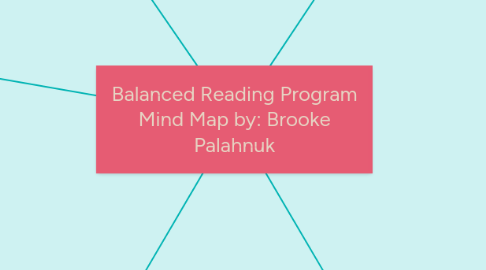
1. Other Considerations
1.1. Rich teaching environment
1.1.1. student work showcased
1.1.2. anchor charts posted to help aid students
1.1.2.1. co-created with students
1.1.3. word walls
1.1.4. classroom library is organized, labelled and centrally-located in class
1.1.4.1. having a comfortable and quiet spaces for reading in classroom
1.1.5. technology available for student-use
1.2. Using culturally-appropriate texts whenever possible
1.3. use of student's native languages in and posted around classroom
1.4. make cross-curricular connections through books and other print materials
2. Read Alouds
2.1. teacher reads to whole group of students
2.1.1. models what it looks like and sounds like to be a fluent reader
2.1.1.1. explicitly teaching skills and strategies for students to see
2.1.1.2. using think alouds to model for students
2.1.2. students can see pictures, but not necessarily the text
2.1.2.1. the text of read aloud is often above the readability of students
2.1.3. students are free to think while listening (as teacher is the one that is putting in all the brain power to decode)
2.2. use of a variety of different types of texts
2.2.1. exposes students to different themes, cultures, etc.
2.3. 10-15 mins. in length
2.4. Elements of lesson
2.4.1. activate background knowledge
2.4.2. introduce text for students
2.4.3. stopping throughout text for intentional teaching moments to reinforce skills or strategies for students
3. Individual Reading
3.1. builds on skills and strategies previously taught in read alouds, shared and guided reading
3.1.1. having word walls, anchor charts, posters, etc. can help aid students during this time
3.2. teacher to provide minimal support to students during this time
3.2.1. teacher can meet with students one-on-one
3.2.1.1. asking questions
3.2.1.2. listen to the reading of a section of text
3.2.1.3. reinforce reading skills/strategies
3.3. students can read in alone, in pairs or small groupings -- reading BY the students
3.4. allows for student choice in text
3.4.1. encourages a love of reading
3.4.2. assistance from teacher to find appropriate books for reading levels
3.4.3. having an accessible classroom library for students to choose from that is clearly labelled and organized
3.5. After reading, reflection and discussion on texts, strategies used, and any challenges they encountered
3.6. Elements of lesson
3.6.1. Before reading, teacher does some kind of mini lesson or book talk on reading strategies to focus student attention
3.7. assessment data
3.7.1. reading behaviours
3.7.2. knowledge and skills
3.7.3. anecdotal records, conferences, journal responses, oral responses, reading log, portfolio, etc.
3.8. approximately 15-20 min. in length
4. Guided Reading
4.1. small group of students working with teacher - reading WITH students
4.1.1. dynamic and flexible student groupings
4.1.2. other students are often working on centre activities while teacher meets with small groups
4.2. students working to apply skills learned in read alouds and shared reading with teacher support
4.3. text used is within the student's reading ability
4.3.1. use of leveled texts
4.4. focus of guided reading lessons differ based on student need
4.4.1. working within the student's "Zone of Proximal Development"
4.4.2. teacher chooses the goal of the lesson, then chooses an appropriate text to go with that goal
4.4.3. Elements of lesson
4.4.3.1. introduction of text
4.4.3.2. activating backgroud knowledge
4.4.3.3. students reading text (quietly, but not in unison)
4.4.3.4. reflecting and discussing text
4.4.3.4.1. problem-solving skills
4.4.3.4.2. higher-order thinking skills
4.5. assessment data
4.5.1. running records
4.5.2. will be used to inform your future practice and lesson focus with student groupings
4.6. 15-20 min in length
5. Shared Reading
5.1. teaches new skills and reinforce ones previously learned
5.1.1. each session should have 1 or 2 intentional teaching points
5.1.1.1. 4 cueing systems
5.1.1.1.1. syntax, graphophonics, pragmatic and semantic
5.1.1.1.2. construct meaning and comprehend troublesome words
5.1.1.2. reading comprehension strategies
5.1.1.2.1. prediction, visualization, making connections, etc.
5.1.1.3. fluency
5.1.2. teacher uses think alouds to model thought processes
5.2. 10-15 min. in length
5.3. uses a text all students can see (such as chart paper, projected on board or big book)
5.3.1. use a variety of different types of texts
5.3.2. texts should have some element of challenge to help promote problem-solving
5.3.3. teacher can use a wand or pointer to help focus students attention on specif areas of passage
5.4. students are active participants
5.4.1. the teacher is reading WITH students
5.5. Elements of lesson
5.5.1. modelling: teacher demonstration, think-aloud to model use of reading strategies
5.5.2. sharing: students demonstrate what they might have learned while reading along with teacher
5.5.3. guiding: teacher supports students to apply learning
5.5.4. independence: student is able to apply skills in independent authentic reading task
